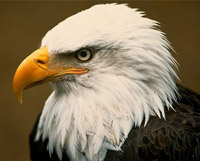 Although the bald eagle was removed from the list of species protected under the federal Endangered Species Act in 2007, the bald eagle continues to be protected by the Bald and Golden Eagle Protection Act (the Eagle Act) and the Migratory Bird Treaty Act. Therefore, if you are planning to develop land that contains bald eagle habitat, you need to be aware of existing federal and state regulations that provide protection for these birds. In addition, portions of the Potomac River have been designated as Bald Eagle Concentration Areas. These are known areas of bald eagle habitat where coordination with the U.S. Fish and Wildlife Service (FWS) and the Virginia Department of Game and Inland Fisheries (VDGIF) will be required for projects that need to obtain federal or state wetland permits. In Virginia, the bald eagle remains classified as state-threatened and is therefore protected under Virginia's Endangered Species Act. As a result, any work requiring state permits, including, but not limited to Virginia Department of Environmental Quality (DEQ) wetland permits, will trigger a compliance review to ensure protection of bald eagles. Note that many land development activities, such as removing overstory trees, building/road construction, utility installation and the alteration of wetlands or shorelines are restricted within the 660-foot management zone during the breeding season (December 15 – July 15). Therefore, the development of any project site that supports, or has the potential to support, bald eagle nesting or foraging habitat should involve early coordination with the FWS, DGIF, the U.S. Army Corps of Engineers (COE) and DEQ. Although the bald eagle was removed from the list of species protected under the federal Endangered Species Act in 2007, the bald eagle continues to be protected by the Bald and Golden Eagle Protection Act (the Eagle Act) and the Migratory Bird Treaty Act. Therefore, if you are planning to develop land that contains bald eagle habitat, you need to be aware of existing federal and state regulations that provide protection for these birds. In addition, portions of the Potomac River have been designated as Bald Eagle Concentration Areas. These are known areas of bald eagle habitat where coordination with the U.S. Fish and Wildlife Service (FWS) and the Virginia Department of Game and Inland Fisheries (VDGIF) will be required for projects that need to obtain federal or state wetland permits. In Virginia, the bald eagle remains classified as state-threatened and is therefore protected under Virginia's Endangered Species Act. As a result, any work requiring state permits, including, but not limited to Virginia Department of Environmental Quality (DEQ) wetland permits, will trigger a compliance review to ensure protection of bald eagles. Note that many land development activities, such as removing overstory trees, building/road construction, utility installation and the alteration of wetlands or shorelines are restricted within the 660-foot management zone during the breeding season (December 15 – July 15). Therefore, the development of any project site that supports, or has the potential to support, bald eagle nesting or foraging habitat should involve early coordination with the FWS, DGIF, the U.S. Army Corps of Engineers (COE) and DEQ.
Under the Eagle Act, it is an illegal action to "take" a bald or golden eagle. Take is defined as "pursue, shoot, shoot at, poison, wound, kill, capture, trap, collect, molest or disturb." The USFWS further defines "disturb" as "to agitate or bother a bald or golden eagle to a degree that causes, or is likely to cause, based on the best scientific information available, (1) injury to an eagle, (2) a decrease in its productivity, by substantially interfering with normal breeding, feeding or sheltering behavior, or (3) nest abandonment, by substantially interfering with normal breeding, feeding or sheltering behavior." The USFWS published revised National Bald Eagle Management Guidelines in 2007 that recommend a single 660-foot radius protection zone around any bald eagle nest. Based on our recent correspondence with the DGIF and DEQ, they now also recognize a single 660-foot management zone around active bald eagle nests. Previously, the state agencies recommended 750-foot primary and 1,320-foot secondary management buffers.
The aforementioned FWS recommendations apply to active and alternate nests for activities involving permanent landscape alterations that may disturb bald eagles. In order for these recommendations not to apply to an alternate nest, you must be able to demonstrate that an alternate nest has been inactive during the preceding five breeding seasons, or provide reasons why it is unlikely the alternate nest will be reused before 5 breeding seasons have passed. Note that the alternate nest itself is still protected by other provisions of the Eagle Act and therefore cannot be destroyed. Activities that involve temporary impacts can generally be conducted outside of the breeding season.
DGIF issued guidance in 2010 regarding how long a survey for state-listed species in Virginia is valid. If a survey was previously conducted and no bald eagle nests were found, that survey remains valid for one (1) year. If bald eagle nests were found during a previous survey, regardless of how long ago, further coordination with DGIF will be required.
An active bald eagle nest can have significant implications on a proposed development plan. WSSI environmental scientists have experience conducting bald eagle habitat evaluations and surveys. Additionally, WSSI regulatory staff are experienced at guiding landowners through the coordination and permit processes with federal and state agencies. Early planning and accurate field studies are vital to avoiding scheduling delays, pitfalls, and other penalties that could result from failure to comply with the existing bald eagle regulations. In our experience, mid-February through the end of March is the preferred time to evaluate whether or not nests are active and to search for bald eagles.
For further information about this topic, or to consult with WSSI regarding bald eagle habitat evaluation or compliance issues on one of your projects, please contact Dan Lucey, Mark Headly, Jennifer Feese, or Doug Chapin. You may also reach any of our staff at 703.679.5600.
|